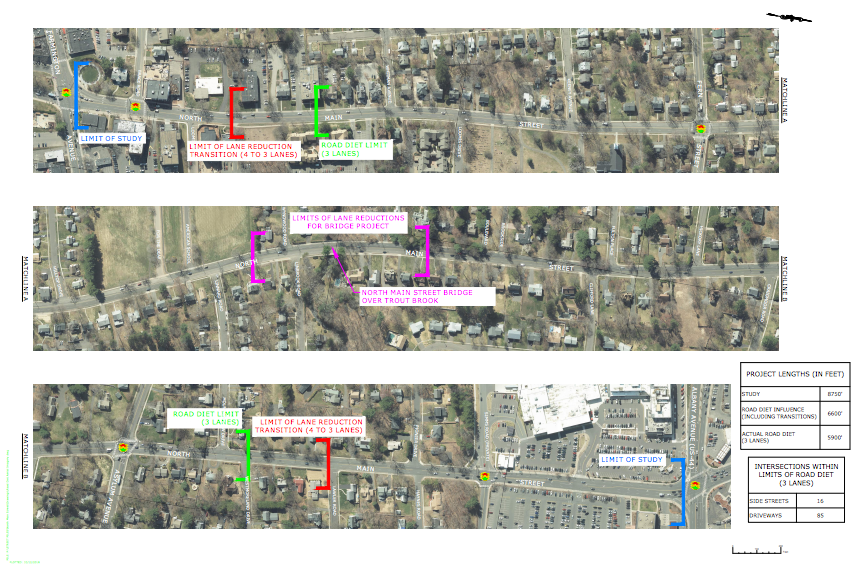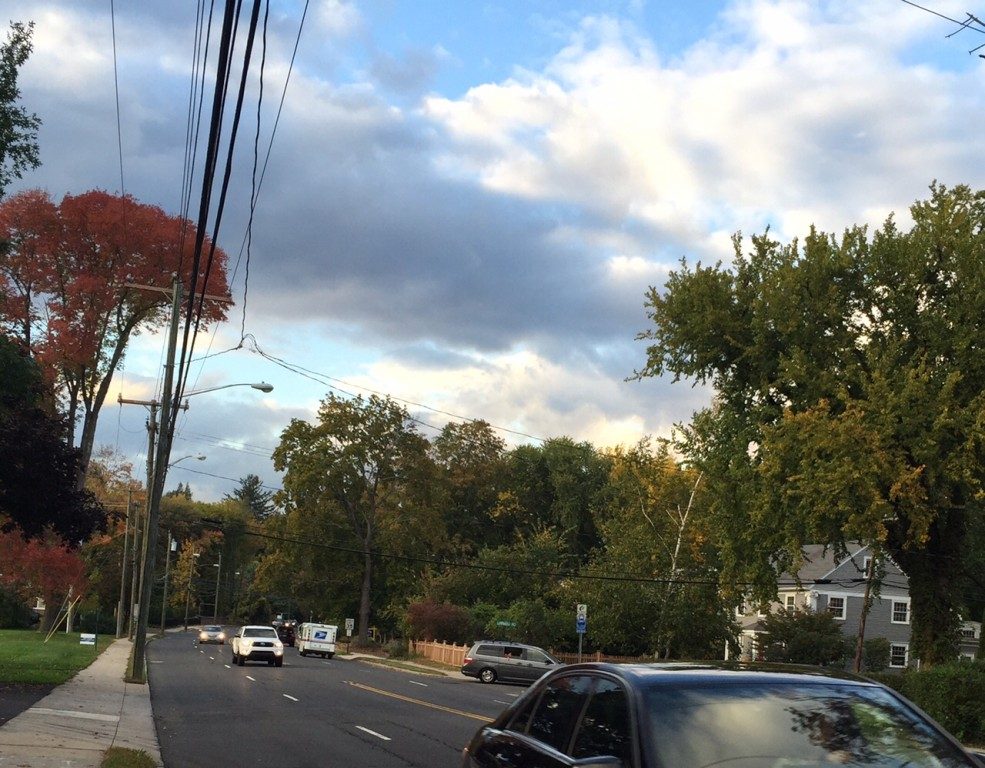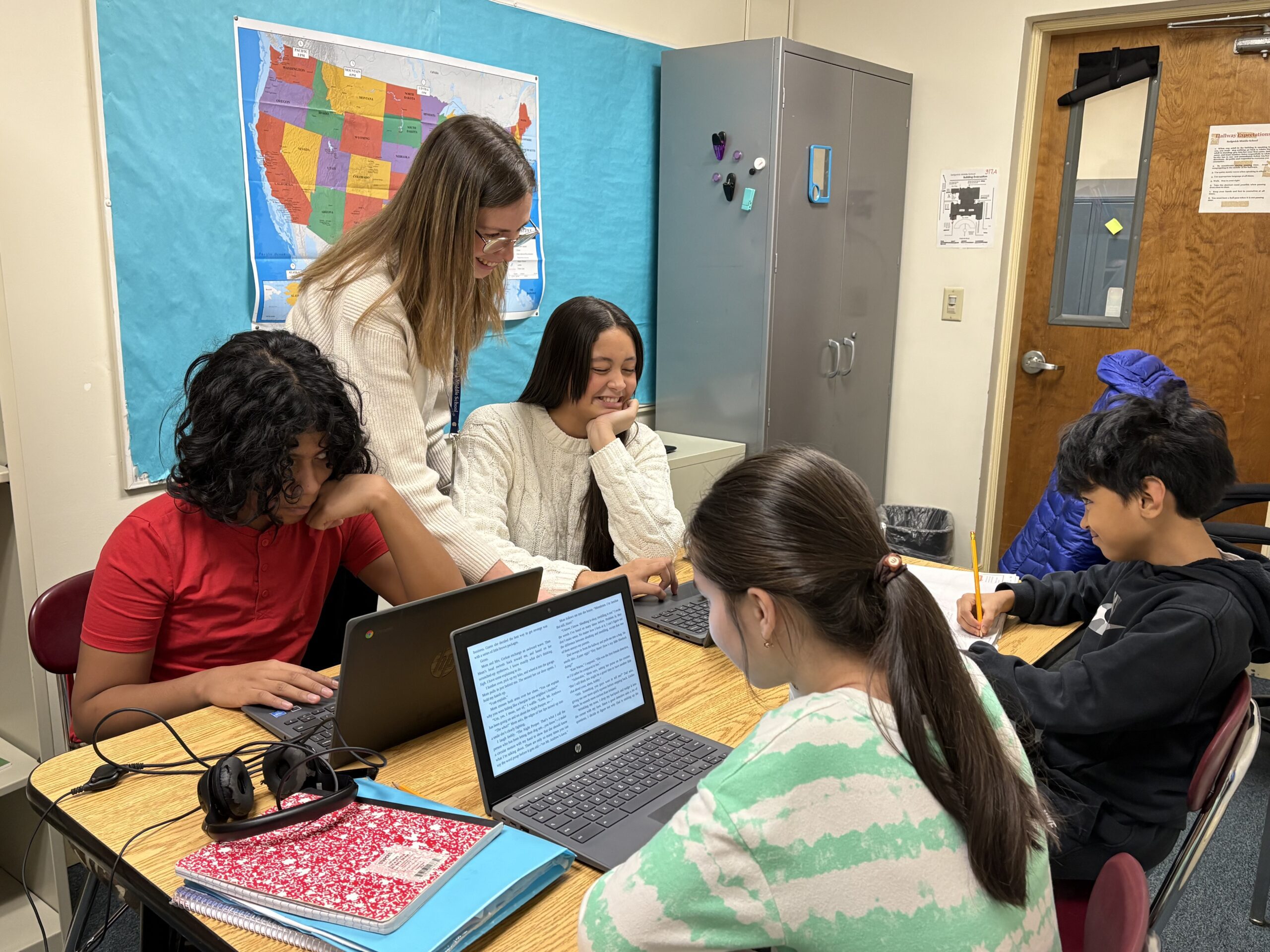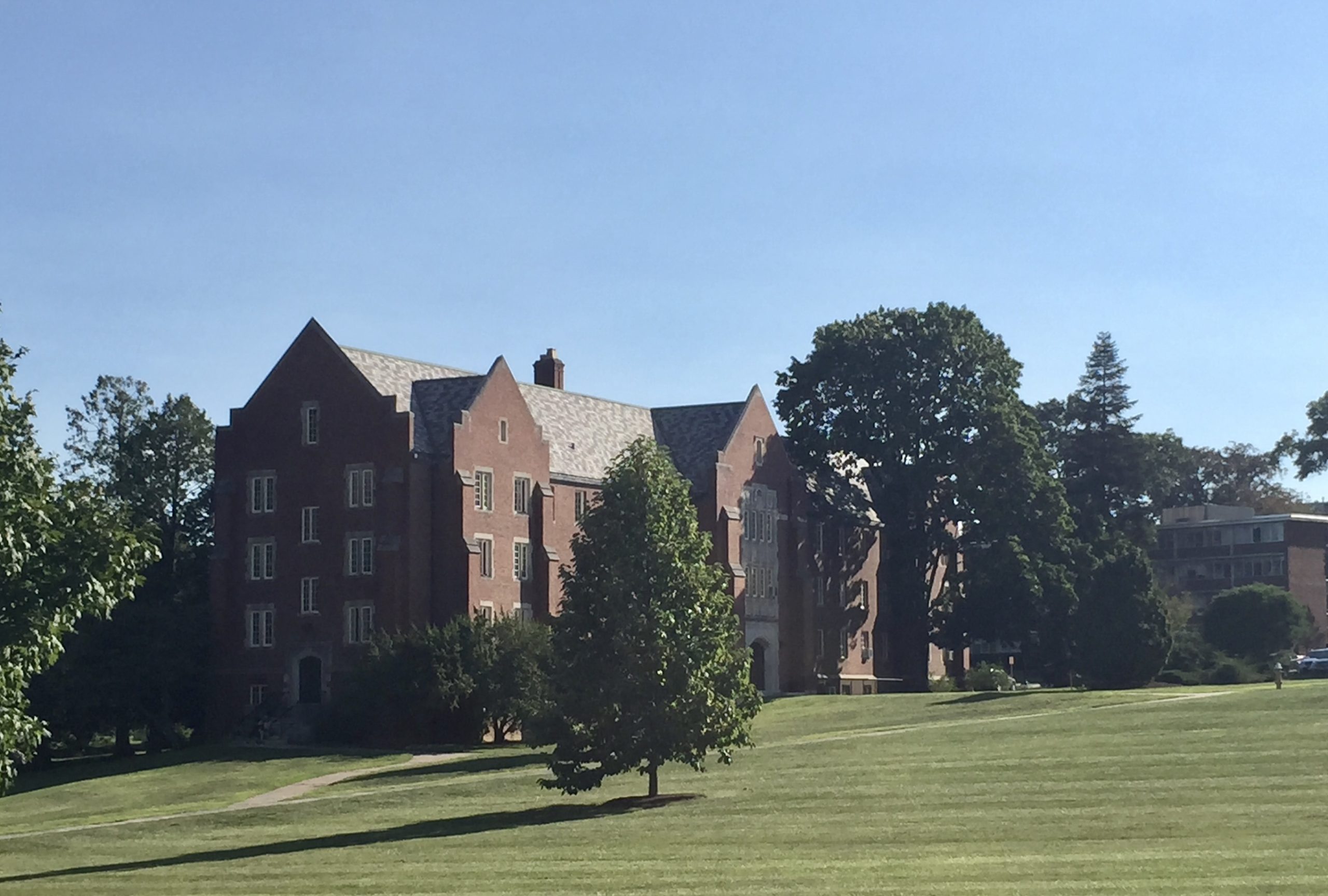West Hartford Residents Ask for Road Diet Trial During North Main Street Bridge Project

Audio By Carbonatix

Courtesy of Town of West Hartford
The North Main Street Bridge repair project is set to begin in the spring of 2019.

North Main Street. Photo credit: Ronni Newton (we-ha.com file photo)
By Ronni Newton
Traffic will be disrupted on the stretch of North Main Street between Fern Street and Asylum Avenue when the reconstruction of the bridge just north of Wyndwood Road begins in the spring of 2019, and residents who are concerned about traffic and safety on that stretch of the roadway are requesting that the town use that as the opportunity to test a road diet since lanes will already need to be closed.
The Town Council’s Community Planning and Physical Services Committee discussed the concept at its meeting Wednesday night, which was attended by about a dozen area residents and members of the town’s Pedestrian and Bicycle Commission, which has been advocating for traffic calming and safety measures on North Main Street.
Residents who spoke out are afraid that a trial of the road diet will never happen if the town waits until after the bridge work and the return to two lanes of traffic in each direction, while town staff is concerned that a trial at the same time as the project would be flawed.
“We’ve got the bridge project. That’s going to happen,” said Town Council member Ben Wenograd, who chairs the Community Planning and Physical Services Committee.
Wenograd said that a vote was not taken during Wednesday night’s meeting, and committee members have asked Town Engineer Duane Martin to provide them with more information before they determine whether or not doing a trial at the same time is viable. Further discussion will take place at the committee’s next meeting on Jan. 16, 2019.
The estimated cost of a road diet trial is $314,237, according to documents provided by Martin to the committee. That estimate includes the cost of doing public outreach in advance of the trial period.
“There’s no question that the road needs to get fixed,” Wenograd said. “It’s too narrow, the 10-foot lanes need to be changed, but the question is how to do it.”
A possible road diet for North Main Street has been in discussion for more than three years. A study was funded by a grant, and undertaken by the Capital Region Council of Governments (CRCOG) in 2015.
Following the completion of the grant-funded study, a draft report was presented by CRCOG to the town in June 2016. Five different options for a road diet were presented, with the most basic – and least costly – option including re-striping of a portion of the existing roadway so that there would be one travel lane in either direction, and a turning lane in the middle, with wider shoulders that could accommodate bicycles traffic and keep vehicle traffic further away from the sidewalks.
The Community Planning and Physical Services Committee discussed plans to study the road diet in January, at a time when the state had frozen the funds that were expected to be used for the bridge work. Funding for the North Main Street bridge project was approved by the State Bond Commission over the summer.
During the bridge rehabilitation, which will begin in the spring of 2019 and will last about 18 months, a section of North Main Street, from just south of Wyndwood Road to just north of the bridge, will be narrowed to one lane in each direction. The traffic patterns will shift four times during the duration of the work, Martin told We-Ha.com on Friday.
Wenograd said that there is going to be a bottleneck due to the bridge work, but he and other committee members have asked Martin for some additional information before deciding whether or not it makes sense to do a trial road diet when there can’t be a third lane along the entire stretch of the roadway, and when other conditions that are part of the construction project may actually make the road diet trial have a more negative outcome than it would have if tested on its own.
In addition, one resident has suggested making the stretch of North Main Street from Fern to Asylum just one lane in either direction without a center turn lane, but leaving the shoulder wide enough to allow traffic to go around turning vehicles, much like the configuration of South Main Street south of Webster Hill Boulevard. Martin will be reporting back to the committee on that idea as well.
Martin told We-Ha.com on Friday that he has two major concerns about doing a road diet trial during the course of the bridge rehabilitation.
One is that the bridge work includes four separate traffic management stages. “Depending on the timing of the road diet trial, we may have to shift the road diet at the bridge,” Martin said. “That’s not insurmountable, just not desirable.” In addition, there’s no ability to have a third lane across the bridge, he said.
More problematic to running a fair trial, Martin said, is that there will be a temporary traffic signal in place during the bridge project. “Traffic will have to stop when cars are exiting Wyndwood and Linbrook,” he said, as well as for pedestrians who activate the signal to cross because the sidewalk will be open on only one side of North Main Street in the area of the construction.
Any changes to traffic signals, even on local roadways, need to to be approved by the Office of State Traffic Administration, said Martin.
There will also be construction equipment that will impede some of the travel area, Martin said.
“Those are all impediments that would not impact [a separate trial of] the road diet, and will negatively impact the test and may actually turn people off the concept of a road diet,” said Martin.
CRCOG’s study applied to the entire stretch of North Main Street between Farmington Avenue and Albany Avenue, said Martin, but town staff and town officials believe that it would be impossible to have a road diet for that entire stretch. Included in the cost of the advance consulting work that he thinks is necessary is determining where to start and stop, he said.
Martin agreed that North Main Street is in need of improvement. The sidewalk is currently very close to the roadway on both sides, he said. While he is not aware of any crashes that have impacted pedestrians, Martin agrees that it “feels very uncomfortable” to be so close to vehicle traffic.
“Speeding on the street is an issue, and a concern,” Martin said, as is the lack of left-turn lanes.
Residents who live in the area think something needs to be done sooner rather than later. “We are concerned that the town doesn’t seem to have the same fervor that we do,” said Scott Franklin, chair of the Pedestrian and Bicycle Commission.
“We have been working very hard and we have been very patient with trying to address our concerns with Town Council and staff,” Matt Warshauer, who lives on North Main Street just north of the intersection with Fern Street, told We-Ha.com on Friday.
Warshauer is passionate about the need to do a trial sooner rather than later, and attended Wednesday’s meeting to express that sentiment.
“CRCOG produced an outstanding study of North Main Street which gave a variety of options, and they specifically recommended that the perfect time would be in conjunction with the bridge project,” said Warshauer.
Warshauer said he thinks it’s “absurd” for the town engineer to say that a conceptual plan doesn’t already exist, and that the only question that really remains to be decided is where to begin the merging of lanes.
“We’ve said go back to the engineer who came up with the merge for the bridge [see diagram below], and come up with a longer merge from Fern to Asylum,” said Warshauer.
Warshauer said that at the time of the CRCOG study, there were 90 accidents per year on the stretch of North Main Street that was studied. He said this year there have already been more than 120 accidents according to information he was provided by the West Hartford Police Department.
“The bottom line is that everyone agrees that North Main Street has issues,” said Martin. A road diet would be a traffic-calming measure. “The idea is to slow traffic, to reduce crashes, to make the road more comfortable for all users,” he said, but its implementation is not without consequences.
“It’s not that simple,” said Martin. “It can’t be done without more detailed framework.”
“The committee hasn’t decided if it will do a trial,” Town Manager Matt Hart said. He is concerned that the results of a trial during the construction won’t match the conditions that would otherwise exist.
There is a cost to undertaking the trial, and Hart agrees with Martin and would not want to implement a trial without proper study and public outreach in advance.
A trial would last from 4-6 months, said Martin. The bridge work is scheduled to be completed in the summer of 2020, and Martin said it would also not make sense to do a trial during the summer months, when traffic is lighter than usual. He said that the fall of 2020 or spring of 2021 would make more sense if the decision of the Town Council is to wait.
“We would get a concept plan, and collect and measure the data,” said Hart. He said it’s important to not just look at North Main Street, but also to look at the impact of traffic diversion to other north-south routes, primarily Trout Brook Drive as well as Mountain Road, and the impact on side streets.
Hart said he’s not talking about re-doing the study that CRCOG already completed, but rather using that to conduct a proper trial. “We don’t think the bridge project would be a good trial,” said Hart.
At this point, Hart’s opinion is that it makes more sense to conduct the trial after the bridge project is completed.
“The committee will meet again in January and decide how they want to proceed,” Hart said. That meeting is currently scheduled for 8 a.m. on Wednesday, Jan. 16, 2019.
Mayor Shari Cantor said it will be up to the Council to decide whether or not to have a trial period and when it makes the most sense to do it. “The Council needs to look at holistic traffic patterns as they address traffic and safety on North Main Street,” Cantor said.
Warshauer said that he and the others who are pushing for the trial are frustrated, and he thinks that the town should speak with leaders of other communities where a road diet has worked as a solution. He said that he didn’t initially think it was good idea when he first heard about it, until he became involved with the CRCOG study.
Traffic diversion will be even worse during the bridge than it would otherwise be, Warshauer agreed, but he doesn’t think that’s a reason to not do the trial. He thinks that it would be more disruptive to wait until people are used to having two travel lanes in each direction again.
Warshauer said that traffic calming measures have been instituted elsewhere in town, and he thinks that dealing with North Main Street sooner rather than later is imperative.
“They are playing ‘auto Russian roulette,'” said Warhauer. “I would argue that since the release of the road diet study, the known solution … the town is now economically and ethically complicit in every single accident and every ingle injury that happens on this road. They’re going to get their pants sued off,” said Warshauer.
Like what you see here? Click here to subscribe to We-Ha’s newsletter so you’ll always be in the know about what’s happening in West Hartford!
 Loading...
Loading...
 Loading...
Loading...




[…] group of residents have been strongly advocating commencing the road diet trial as soon as possible. At a meeting of the Community Planning and Physical Services Committee on Dec. 5, 2018, town staff […]